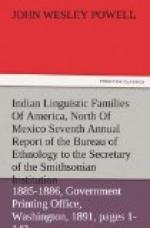[Footnote 69: On p. 119, Archaeologia Americana.]
GEOGRAPHIC DISTRIBUTION.
The area occupied by this family was very extensive. It may be described in a general way as extending from the Savannah River and the Atlantic west to the Mississippi, and from the Gulf of Mexico north to the Tennessee River. All of this territory was held by Muskhogean tribes except the small areas occupied by the Yuchi, Na’htchi, and some small settlements of Shawni.
Upon the northeast Muskhogean limits are indeterminate. The Creek claimed only to the Savannah River; but upon its lower course the Yamasi are believed to have extended east of that river in the sixteenth to the eighteenth century.[70] The territorial line between the Muskhogean family and the Catawba tribe in South Carolina can only be conjectured.
[Footnote 70: Gatschet, Creek Mig. Legend, 1884, vol. 1, p. 62.]
It seems probable that the whole peninsula of Florida was at one time held by tribes of Timuquanan connection; but from 1702 to 1708, when the Apalachi were driven out, the tribes of northern Florida also were forced away by the English. After that time the Seminole and the Yamasi were the only Indians that held possession of the Floridian peninsula.
PRINCIPAL TRIBES.
Alibamu.
Apalachi.
Chicasa.
Choctaw.
Creek or Maskoki proper.
Koasati.
Seminole.
Yamacraw.
Yamasi.
Population.—There is an Alibamu town on Deep Creek, Indian Territory, an affluent of the Canadian, Indian Territory. Most of the inhabitants are of this tribe. There are Alibamu about 20 miles south of Alexandria, Louisiana, and over one hundred in Polk County, Texas.
So far as known only three women of the Apalachi survived in 1886, and they lived at the Alibamu town above referred to. The United States Census bulletin for 1890 gives the total number of pureblood Choctaw at 9,996, these being principally at Union Agency, Indian Territory. Of the Chicasa there are 3,464 at the same agency; Creek 9,291; Seminole 2,539; of the latter there are still about 200 left in southern Florida.
There are four families of Koasati, about twenty-five individuals, near the town of Shepherd, San Jacinto County, Texas. Of the Yamasi none are known to survive.
NATCHESAN FAMILY.
> Natches, Gallatin in Trans. and Coll.
Am. Antiq. Soc., II, 95, 806,
1836 (Natches only). Prichard, Phys.
Hist. Mankind, V, 402, 403, 1847.
> Natsches, Berghaus (1845), Physik. Atlas, map 17, 1848. Ibid., 1852.




